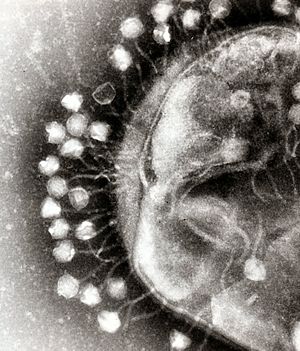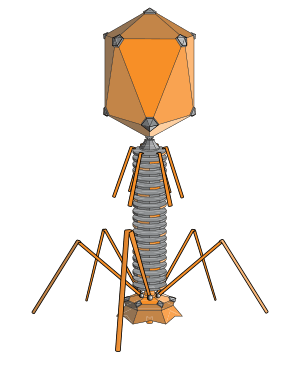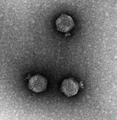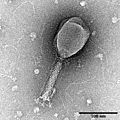Bacteriophage facts for kids
A bacteriophage is a tiny virus that attacks and infects bacteria. People often just call them phages.
Phages are super common. You can find them almost everywhere on Earth where bacteria live. Just like viruses that infect plants or animals, phages come in many different shapes and sizes. They also work in many different ways.
Contents
What Are Phages Made Of?
Phages have a simple structure. They usually have an outer shell made of protein. Inside this shell, they carry their genetic material. This genetic material is like a set of instructions for the phage.
The genetic material can be different types. It might be single-stranded (ssRNA or ssDNA) or double-stranded (dsRNA or dsDNA). It can also be arranged in a circle or a straight line.
Phages are incredibly small. They are usually between 20 and 200 nanometers in size. To give you an idea, a nanometer is one billionth of a meter!
Phage Structure: A Closer Look
The top part of many phages looks like a tiny, 20-sided dice. This shape is called an icosahedron. It has 20 flat sides and 30 edges. This is where the phage keeps its DNA, which is its genetic information.
This dice-like head often sits on a tail. The tail can have leg-like fibers at the bottom. These fibers help the phage attach to bacteria.
How Phages Work
Phage genomes (their full set of genetic instructions) can be quite small. Some phages only have enough instructions for four genes. Others can have hundreds of genes.
When a phage finds a bacterium, it injects its genetic material into it. Once inside, the phage uses the bacterium's own machinery. It forces the bacterium to make more copies of the phage. This process is called replication.
Where Do Phages Live?
Phages live wherever bacteria are found. This means they are almost everywhere! You can find them in soil, in the intestines of animals, and even in your own body.
They are especially common in sea water. Scientists have found huge numbers of phages in the ocean. For example, some areas can have up to 900 million phages in just one milliliter of water. It's thought that up to 70% of bacteria in the ocean might be infected by phages.
Phages and Medicine
Phages have been known for a long time. For over 90 years, they have been used as a way to fight bacterial infections. This was especially true in places like the former Soviet Union and Central Europe. They were used as an alternative to antibiotics.
However, it wasn't until 1939 that scientists truly understood what phages were. That's when Helmut Ruska first saw a phage using an electron microscope.
Fighting Superbugs
Today, phages are being studied again. They might be a helpful treatment against bacteria that have become resistant to antibiotics. These are often called "superbugs." Phages could offer a new way to fight infections that current medicines can't handle.
On the other hand, some phages can make certain infections worse. For example, they can sometimes protect bacteria inside biofilms. Biofilms are sticky layers of bacteria. If phages help bacteria hide in these biofilms, it can make infections like pneumonia harder to treat.
Images for kids
See also
 In Spanish: Bacteriófago para niños
In Spanish: Bacteriófago para niños










